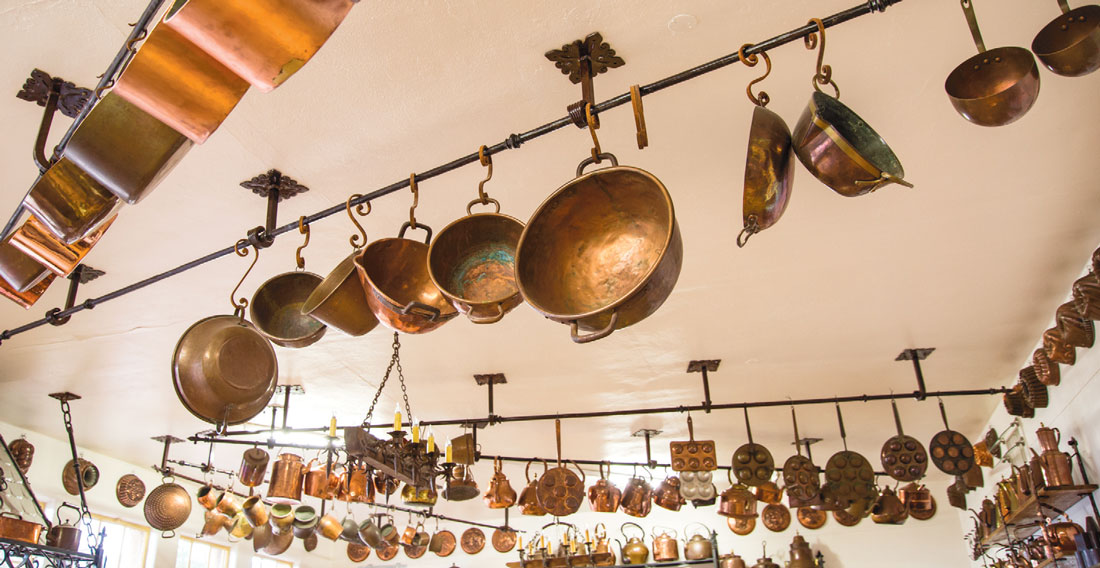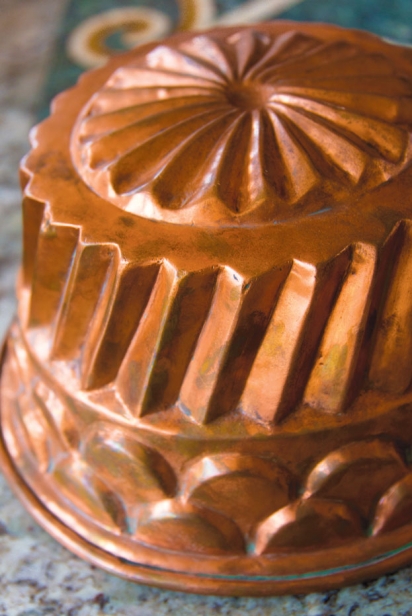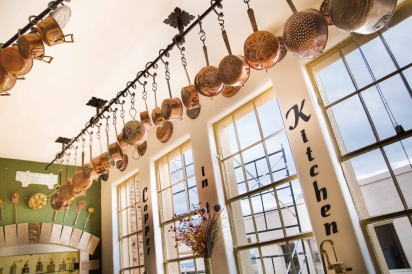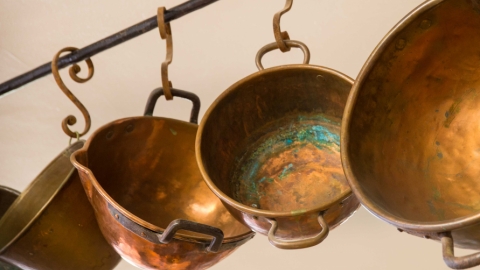Copper Cooking Pots Shine at Copper Arts Museum
Before there was Calphalon or All-Clad, stainless steel, aluminum or even cast iron, there was copper. For thousands of years it was the only metal available for cooking pots. For some, it remains the metal of choice even today.
If you love copper cookware, then the Copper Art Museum in Clarkdale, Arizona, is a must-see. The museum opened in 2012 to honor the shared centennial of the State of Arizona and the town of Clarkdale, a company town built for the workers of the smelter associated with the vast copper mine under Mingus Mountain.
The collection originated in Minnesota, with roots in a 1919 antique store owned by the Meinke family. It is housed in the handsome Spanish Colonial Revival building (1928) that was once the Clarkdale high school. Thematically divided among several rooms, it covers the origins, history and chemistry of copper, its fabrication and uses, decorative art and architectural elements, distillery and beverage equipment and every imaginable household and kitchen item that has been made of the metal. Other special displays include tin and brass objects, even etched casings from World War I called “trench art.”
The large and beautiful culinary section boasts an array of pots and pans of all sizes, including miniatures. There are tureens, molds, braziers, trays, roasters, urns, basins, colanders, buffet warmers and more. In the high-ceilinged room full of natural light, the rosy glint beaming from so many artifacts creates a warm ambience uniquely characteristic of copper.
The selection of objects highlights the fine craftsmanship and artistry that can be achieved with this remarkable material. Hand-wrought and hammered pans with brass or iron handles and rivets are classic. The slotted spoons and pierced colanders, kettles and pitchers are less commonly found.
The elaborate Victorian molds once used for bombes, ices and aspics are architecturally whimsical and delightfully decorative. These fussy, spectacular but labor-intensive dishes were the domain of wealthier households with a kitchen staff; today the molds are rarely used for more than decorative ice for punch bowls.
Not just decorative, the museum is a trove of copper facts:
Copper, the first metal discovered by humans around 11,000 years ago, became the definitive material of the Bronze Age. The advent of metallurgy was a milestone in the advancement of civilization.
The first metal tools, including cooking pots and pans, were hammered from this remarkable ore, which is strong but malleable, does not rust or degrade, conducts heat well and is endlessly recyclable.
As a nutrient copper, like salt, is essential to life, and naturally occurs in many common foods, such as nuts, beans, legumes and some vegetables. But ingesting too much of it can cause illness. Nobody knows how or when, but somehow very early on, people discovered that it was best to line copper pots with tin (another ancient metal) to inhibit acidic reactions and absorption of copper when cooking food. Today, many copper vessels are lined with stainless steel.
Confectioners, however, use unlined pots for fudge, nut brittles and other sweets. The even heat conduction seems to create a superior product. Egg whites, in contact with the copper, famously gain more volume and hold their structure when whipped in an unlined copper bowl.
Copper also has antimicrobial properties, a feature that makes it valuable for storing water. Most water-heating tubs and vessels are unlined. There is a lot of chemistry around the use of copper!
As essential tools of civilized life, copper pots and other utensils were made to last a long time and be passed on from generation to generation. Because copper does not deteriorate with use, it could also be melted down to make tools or weapons in times of war.
The disadvantages? Copper is heavy, and requires regular cleaning to retain its luster, as well as re-tinning about every 10 years.
In the 19th century, cast-iron cookware came into being, and began to replace copper. At first, only the wealthiest households could afford cast iron. Over time, it became more accessible to standard household kitchens.
Then in the 20th century came aluminum cookware, which had many of the same conductive qualities as copper and iron, and was much lighter in weight. But it is reactive with acids, becomes pitted over time, and stains. There is also some question as to its safety for human health. Stainless steel cookware then emerged, a strong metal that is nonreactive, but one that is not the best conductor of heat.
Today, the latest high-grade cookware is constructed by laminating sheets of copper, and sometimes aluminum, with stainless steel to benefit from the best qualities of each metal. Just like pure copper pots, these innovative wares are expensive. But they offer many conveniences as well as good cooking properties.
Still, some people consider a copper cooking pot the best. It remains a treasure, for its aesthetic appeal as well as its cooking qualities. After seeing the wonders of the copper culinary world in the museum, it is easy to long for the beauty of this material.
Associated with the museum is a shop in Jerome of vintage and antique copper items. Browsing through the store one day, I learned that the museum store re-tins copper pots. I eagerly brought in some old pieces from my grandmother’s attic. Not only were they expertly re-tinned, Drake Meinke, the founder of the museum and an expert in copperware, could identify the country of origin and the approximate dates they were made. He showed me the traits of the fabrication and details of handiwork by which he determined their origins. Every culture seems to have its own techniques.
For both a learning experience and an aesthetic adventure, the Copper Art Museum is a beautiful feast for the eyes and a richly informative place to visit.
Contact Info
Copper Arts Museum
849 Main St.
Clarkdale AZ 86324
928-649-1858
copperartmuseum.com
Hours of operation: Daily 10am-5pm;
closed Christmas and New Year’s Day
Admission Fee: Adults $9, Seniors (60+) $8,
Veterans and Students $8 with proper ID,
Youth ages 10-17 $3, Children ages 5-9 $1
Copper Mountain Antiques
Old Hwy. 89A (880-D Hampshire Ave.)
Jerome AZ 86331
928-634-3273
For more photos, see ediblephoenix.com/copper.








